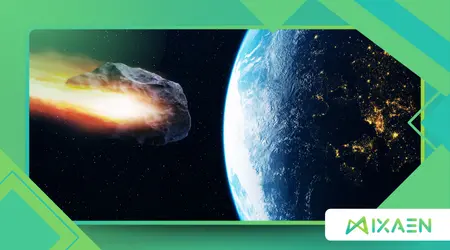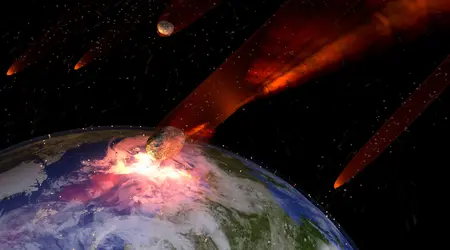The Biggest Asteroid Impacts on the Solar System: Discover the Giant Craters

The Solar System bears the scars of countless asteroid impacts, each telling a story of chaos and transformation.
Anúncios
These colossal collisions have shaped planets, moons, and even the course of life itself.
From Earth to the moons of Jupiter, the evidence of these cosmic encounters is etched into the very fabric of our celestial neighborhood.
But what are the largest and most significant craters left behind by these impacts?
And what can they teach us about the history of our Solar System?
Let’s embark on a journey to uncover the giants among these scars.
The Science Behind Asteroid Impacts
Asteroid impacts are more than just dramatic events; they are fundamental to understanding the evolution of planetary bodies.
When a massive asteroid collides with a planet or moon, the energy released can vaporize rock, create shockwaves, and leave behind a crater that serves as a permanent record of the event.
The size and shape of these craters depend on factors like the asteroid’s velocity, mass, and the composition of the impacted surface.
One of the most fascinating aspects of these collisions is their dual nature.
While destructive, they also play a role in planetary formation and even the delivery of essential elements like water and organic compounds.
For instance, scientists believe that water on Earth may have been delivered by icy asteroids during the planet’s early history.
Furthermore, these impacts have influenced planetary atmospheres.
Large asteroid strikes can eject significant amounts of material into space, altering atmospheric composition and even triggering climate shifts.
Such events could explain mass extinctions and significant evolutionary changes on Earth and other planets.
Asteroid collisions also generate secondary effects such as seismic activity and tsunamis.
The impact’s force can create massive shockwaves, altering landscapes and triggering long-term geological transformations.
These changes are vital for understanding planetary evolution and the resilience of life in extreme conditions.
In addition, studying impact craters allows scientists to estimate the frequency of asteroid collisions in different regions of the Solar System.
By analyzing crater distribution on planets and moons, researchers gain valuable insights into the movement of celestial bodies and the likelihood of future impacts.
+ Sunspots and Their Impact on Earth’s Climate
The Largest Craters in the Solar System
The Solar System is home to some truly massive craters, each a testament to the sheer power of asteroid impacts.
Below, we explore two of the most impressive examples:
1. South Pole-Aitken Basin (Moon)
Located on the far side of the Moon, the South Pole-Aitken Basin is one of the largest and oldest known impact craters in the Solar System.
Stretching over 2,500 kilometers in diameter and 13 kilometers deep, this colossal basin is believed to have formed over 4 billion years ago.
The impact that created this basin was so powerful that it likely penetrated the Moon’s crust, exposing materials from the mantle.
NASA’s Lunar Reconnaissance Orbiter has been studying this region to better understand the Moon’s composition and history.
This crater is also of significant interest for future lunar exploration.
Scientists speculate that its depth and exposed mantle materials could offer clues about the Moon’s interior.
Additionally, the basin may hold ancient ice deposits, making it a potential resource for future crewed missions.
Given its vast size, South Pole-Aitken Basin continues to challenge existing impact models.
Researchers are investigating how such an enormous crater could form without completely disrupting the Moon’s structure, adding another layer of intrigue to its study.
Its immense size also raises questions about the early Solar System’s impact environment.
If an object massive enough to create this basin struck the Moon, it suggests that similarly large impacts may have occurred elsewhere, potentially shaping the formation of other planetary bodies.

2. Hellas Planitia (Mars)
Mars is home to Hellas Planitia, a massive impact basin that spans approximately 2,300 kilometers in diameter and is over 7 kilometers deep.
This crater, formed by an ancient asteroid impact, is one of the most prominent features on the Red Planet.
Hellas Planitia’s formation likely had a profound impact on Mars’ climate and geology.
The energy released during the collision may have triggered volcanic activity and even influenced the planet’s atmosphere.
Today, the basin is a key area of interest for scientists studying Mars’ past and potential for harboring life.
Another fascinating aspect of Hellas Planitia is its atmospheric pressure.
Being one of the lowest points on Mars, the basin has higher atmospheric pressure than other regions, potentially making it a more hospitable environment for liquid water in the past.
Additionally, the basin’s structure provides valuable insights into impact mechanics.
The layers of exposed rock and mineral deposits allow researchers to study how Mars’ surface evolved following the impact, enhancing our understanding of planetary resurfacing processes.
The crater’s depth and vast size suggest that the impactor responsible for its formation was among the largest objects to collide with Mars.
Studying Hellas Planitia helps refine models of planetary impact rates and their effects on planetary habitability.
++ The Mystery of Tiger Stripes on Enceladus: Space Geysers
The Role of Asteroid Impacts in Planetary Evolution
Asteroid impacts are not just random acts of destruction; they are integral to the evolution of planets and moons.
For example, the Late Heavy Bombardment, a period around 4 billion years ago, saw a surge in asteroid impacts across the Solar System.
This era played a crucial role in shaping the surfaces of terrestrial planets and may have even influenced the emergence of life on Earth.
Moreover, impacts can create environments conducive to life.
Craters often become sites for hydrothermal activity, providing heat and nutrients that could support microbial life.
This makes impact craters prime targets for astrobiological research, particularly on Mars and icy moons like Europa.
Impact events also contribute to planetary resurfacing.
They redistribute materials across planetary surfaces, creating new geological formations and altering atmospheric compositions over time.
These effects have shaped planets like Venus and Mercury, where large craters and basins reveal the long history of bombardments.
Even today, asteroids continue to shape planetary evolution.
While large impacts are rare, smaller asteroid collisions occur regularly and provide valuable opportunities to study the immediate effects of such events on planetary atmospheres and surfaces.
Additionally, asteroid impacts play a role in the formation of planetary rings and debris fields.
Some of Saturn’s rings, for instance, may be remnants of ancient impact events that shattered moons or asteroids, leaving behind scattered material.
These massive collisions also influence planetary magnetic fields.
Some theories suggest that intense impacts could disrupt or even help generate magnetic fields on certain planetary bodies, adding another dimension to their role in planetary evolution.
